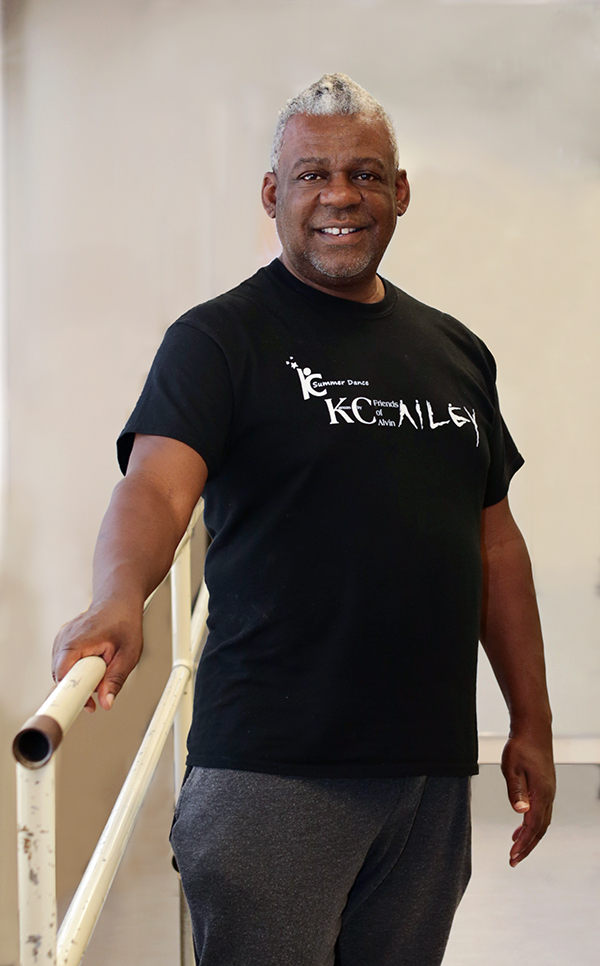
Presented by Equity Bank
When he is all alone and the music comes on, what might be the signature move for a dance professional? “Think the urban version of the ‘dancing baby,’” says Tyrone Aiken, chief artistic officer of Kansas City Friends of Alvin Ailey. In-the-moment joyful. “When I’m dancing, I feel connected to a spiritual realm,” he says.
He not only dances. He teaches, choreographs, mentors, leads, organizes, and does whatever else it takes to connect young people—and the entire community—through dance.
Nationally, Aiken’s choreographic credits include works for Dance Institute of Washington, Kwanzaa performed at the Kennedy Center, Summerland commissioned by Dance Theater of Harlem’s Virginia Johnson, and works for the Alvin Ailey American Dance Center, The Dance Theater of Harlem Ensemble Company, and Blue Mercury Dancing Company. In Kansas City, he has choreographed for The Lyric Opera, The Coterie Theater, The KC Symphony, Wylliams/Henry Dance Theatre, KC Ballet, and the KCRep.
Aiken has taught at universities and colleges, elementary and secondary schools, and conservatories throughout Europe, Asia, and the United States.
He came to Kansas City in 1995 as the director of artistic and educational programs and then became the executive director from 2005 – 2015.
As the executive director, Aiken successfully launched KCFAA’s move to the 18th and Vine Jazz District, received the Neighborhood Builders Award from Bank of America, and led KCFAA through a strategic plan with Michael Kaiser creating a new Festival On the Vine and Symposium series.
His upcoming partnerships include projects with The Nelson/Atkins Museum, Heartland Men’s Chorus, and the American Jazz Museum. The dance goes on.
How does a kid growing up in Amityville, New York, (famous for that ghost movie) and a member of the German club come to be the chief artistic officer for Kansas City Friends of Alvin Ailey?
I come from a large family of 16. My parents were sharecroppers from South Carolina and a part of the Great Migration to New York. We always danced at home during family parties: the Hustle, line dancing, and German folk dancing. Ballet came first at Sandy’s School of Dance and later the Eglevsky School of Ballet and the Long Island School of the Performing Arts. After high school I continued my training in the Certificate Program at the Ailey School in 1981. At the Ailey School, I found myself reflected in one of the best training programs in the world. My connection to The Ailey has been consistent and continues today. Working at AileyCamp since 1991 and KCFAA since 1995 has been rewarding.
Although you teach many styles of contemporary dance from jazz to ballet and hip-hop, do you have a personal preference?
My personal preference is teaching the Horton technique created by Lester Horton between 1932 and 1953. The technique is linear, full of movement that is codified in forms called studies and fortifications. Think of a yoga chart that comes to life through movement.
Right now, you are involved in AileyCamp 2023, a summer day camp for kids ages 10 to 14 centered around dance. What do you hope they gain from their camp experience?
The camp is centered around dance and more than dance, including art, percussion, and creative writing. It is also about the whole child, the psychological and social wellbeing of the child. In personal development, campers discover the importance of empathy, team building, and drugs and their effects and impacts on our bodies. AileyCamp gives campers opportunities to become passionate about learning, the arts, wellness, and health.
You have worn many hats in your career: student, dancer, performer, administrator, teacher. If the spotlight were on you for This Is Your Life, what do you think you’ve been put on this earth to do?
To have a conversation using the art of dance with people that are like me and especially those that are not. That conversation is in the form of words, movement, class, and being in community with others.


